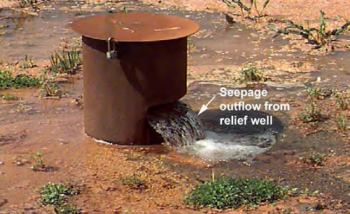Relief Wells: Difference between revisions
m (Grichards moved page Relief wells to Relief Wells without leaving a redirect) |
No edit summary |
||
| Line 13: | Line 13: | ||
<!-- Introductory paragraph or topic page summary --> | <!-- Introductory paragraph or topic page summary --> | ||
“Relief wells are typically vertical drains placed to relieve uplift pressure at the downstream toe of an embankment. [[Piezometers]] are typically located equidistant between two wells. Under maximum hydraulic load, the piezometric level at the downstream toe of an embankment should be lower than the ground surface”.<ref name="EM 1110-2-1908">[[Instrumentation of Embankment Dams and Levees (EM 1110-2-1908) | EM 1110-2-1908 Instrumentation of Embankment Dams and Levees, USACE, 2020]]</ref> | |||
"All water retention structures are subject to seepage through their foundations and abutments. In many cases the seepage may result in excess hydrostatic pressures or uplift pressures beneath elements of the structure or landward strata. Relief wells are often installed to relieve these pressures which might otherwise endanger the safety of the structure. Relief wells, in essence, are nothing more than controlled artificial springs that reduce pressures to safe values and prevent the removal of soil via piping or internal erosion. The proper design, installation, and maintenance of relief wells are essential elements in assuring their effectiveness and the integrity of the protected structure."<ref name="EM 1110-2-1914">[[Design, Construction, and Maintenance of Relief Wells (EM 1110-2-1914) | Design, Construction, and Maintenance of Relief Wells (EM 1110-2-1914) (USACE, 1992)]]</ref> | "All water retention structures are subject to seepage through their foundations and abutments. In many cases the seepage may result in excess hydrostatic pressures or uplift pressures beneath elements of the structure or landward strata. Relief wells are often installed to relieve these pressures which might otherwise endanger the safety of the structure. Relief wells, in essence, are nothing more than controlled artificial springs that reduce pressures to safe values and prevent the removal of soil via piping or internal erosion. The proper design, installation, and maintenance of relief wells are essential elements in assuring their effectiveness and the integrity of the protected structure."<ref name="EM 1110-2-1914">[[Design, Construction, and Maintenance of Relief Wells (EM 1110-2-1914) | Design, Construction, and Maintenance of Relief Wells (EM 1110-2-1914) (USACE, 1992)]]</ref> | ||
Revision as of 23:48, 5 December 2022

|
| "Figure 7-9. Relief well seepage outflow. Although relief wells are not typically installed for the primary purpose of seepage water monitoring, their outflow can be collected, measured, and evaluated similar to open piezometers or observation wells."[1] |
“Relief wells are typically vertical drains placed to relieve uplift pressure at the downstream toe of an embankment. Piezometers are typically located equidistant between two wells. Under maximum hydraulic load, the piezometric level at the downstream toe of an embankment should be lower than the ground surface”.[2]
"All water retention structures are subject to seepage through their foundations and abutments. In many cases the seepage may result in excess hydrostatic pressures or uplift pressures beneath elements of the structure or landward strata. Relief wells are often installed to relieve these pressures which might otherwise endanger the safety of the structure. Relief wells, in essence, are nothing more than controlled artificial springs that reduce pressures to safe values and prevent the removal of soil via piping or internal erosion. The proper design, installation, and maintenance of relief wells are essential elements in assuring their effectiveness and the integrity of the protected structure."[3]
"Relief wells also function as observation wells, but their primary purpose is to reduce the hydraulic head at selected locations along the seepage flow path... Relief wells for dams have specific problems associated with the plugging of the filter packs or the accumulation of bacteria or carbonates (USACE 1995). It is often necessary to install piezometers adjacent to relief wells to measure and monitor the pressure increases associated with clogged wells. Relief wells typically require regular maintenance for long-term proper functioning, including re-development, chemical treatments, and disinfection."[1]
Best Practices Resources
![]() Evaluation and Monitoring of Seepage and Internal Erosion (FEMA P-1032) (FEMA, 2015)
Evaluation and Monitoring of Seepage and Internal Erosion (FEMA P-1032) (FEMA, 2015)
![]() Instrumentation of Embankment Dams and Levees (EM 1110-2-1908) (USACE, 2020)
Instrumentation of Embankment Dams and Levees (EM 1110-2-1908) (USACE, 2020)
Trainings
Citations:
Revision ID: 4937
Revision Date: 12/05/2022
